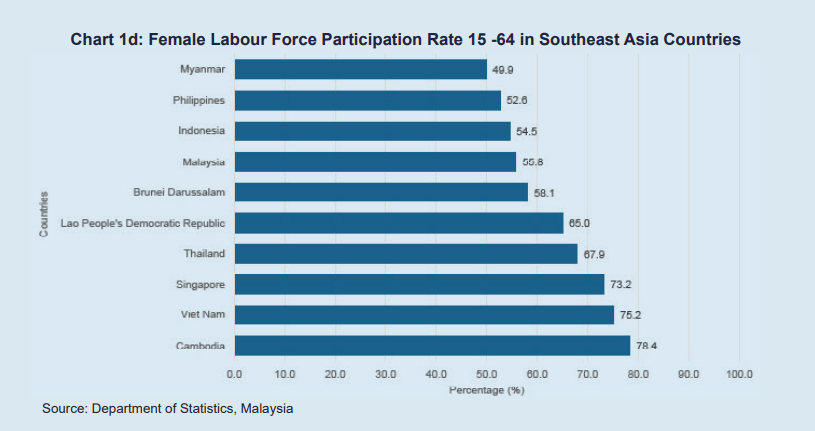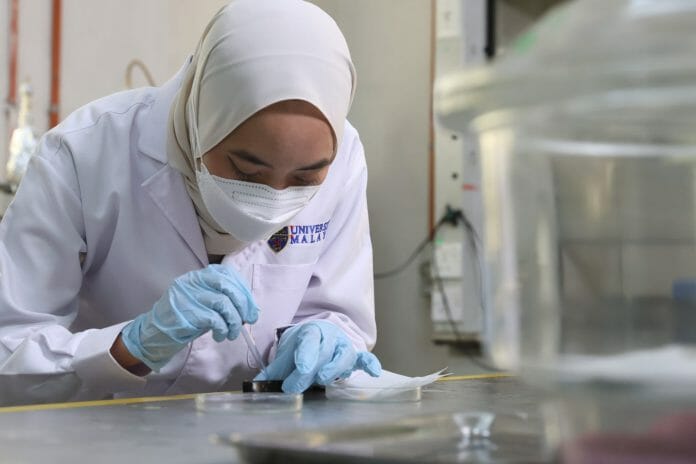By Norfariza Hanim Kasim; Muhammad Hazim Mohd Abd Rahim, Population & Demographic Statistics Division, Department of Statistics Malaysia
A quantitative overview of Malaysia’s progress towards gender equality can be obtained from statistical patterns, including women’s representation in labour force involvement. Gender equality appears to gain momentum as seen by positive indications such as the growing number of women obtaining higher education and occupying important jobs.
However, the story of women’s empowerment goes beyond numbers and percentages as it also includes women’s tenacity and fi ghting for equal rights for men and women. Investigating these stories in detail is necessary to understand women’s empowerment of labour force in Malaysia.
POPULATION IN MALAYSIA
According the statistics from Department of Statistics Malaysia, the total population of Malaysia including Noncitizens in 2023 was estimated at 33.4 million which 17.5 million comprised of males and 15.9 million were females. As of 2023, Malaysia’s demographic composition highlights the signifi cant role of females across distinct age ranges. The female population aged 15-64 years (working age) comprised of 11.0 million, 69.0 per cent of the total female population. Male population aged in the same age group comprised of 12.4 million (70.9%) from the total male population.
In the 0-14 years age group, young females constitute 23.0 per cent of the females population, with 3.7 million individuals contributing to the younger generation. Transitioning to the crucial 15-64 years age range, which represents the core working-age population, females make up at 69.0 per cent, with 11.0 million women. For the 65 years and over category, females account for 8.0 per cent of the population, totalling 1.3 million women.
FEMALE LABOUR FORCE TRANSFORMATION
- Labour Force Participation Rate Increased from 1982
Labour force participation rate over four decades in Malaysia shows a transformation in the proportion of women working in the country. Female labour participation rate stood at 44.5 per cent in 1982, but by 2022, the percentage had increased to about 55.8 per cent (Chart 1a). This evolution is a refl ection of shifting public perceptions as well as the results of national programmes meant to integrate women into the economy.

- Women’s Labour Force Participation Rate Peaked at the Age of 25-29
For both males and females, the labour force participation rate tends to be higher for younger age groups and gradually decreases as people get older. This pattern is common in many countries, as younger individuals are typically more likely to be in the workforce or actively seeking employment, while older individuals may transition to retirement or other activities. Among males, the highest participation rate is in the 40-44 age group at 98.4%. The participation rate remains relatively high for men until the 55-59 age group, where it starts to decline drastically. Among females, the highest participation rate is in the 25-29 age group at 77.5%. Unlike males, the female participation rate decreases as age increases, and it drops more steeply for the 55-59 and 60-64 age groups.
Chart 1b highlights age-related and gender-based diff erences in labour force participation rates in Malaysia in 2022. While younger age groups generally have higher participation rates, there are signifi cant disparities between males and females across all age groups, with males having higher rates of labour force participation. Gender disparities in the labour market remain an important aspect of labour force dynamics that policymakers may need to address to promote greater gender equality in the labour force.

- Labour Force Participation Rate Across Urban and Rural Landscapes
In both urban and rural areas, male participation rates are consistently higher than female participation rates across all age groups. This indicates a gender disparity in workforce participation, with males having higher rates. The largest gender gap can be seen in rural areas, especially in the older age group, where male participation is signifi cantly higher than female participation. Females generally have lower participation rates, and the rates tend to decline with age for both urban and rural areas.
These data shows that there are notable diff erences in labour force participation rates based on age, gender, and urban/rural settings in Malaysia in 2022. Urban areas generally have higher participation rates than rural areas, and males tend to have higher participation rates than females across the board (Chart 1c).

- Female Labour Force Participation by Occupation
Based on the occupational category, from 2015 to 2022, the share of female employed persons in the services and sales workers category increased from year to year (2015: 29.5%; 2022: 33.3%) followed by clerical support workers (2015: 16.6%; 2022: 17.5%) and professional categories (2015: 15.3%; 2022: 17.2%). The increasing trend of female employment in services and sales workers category can also be observed in various countries, with the share of female workers in this category often exceeds 50.0 per cent in some industries, such as entertainment providers and administrative and support services. The share of female employed persons in services and sales workers category has been consistently higher than male. - The Reason For Not Seeking Work
The population outside labour force consists of individuals who are neither employed nor unemployed. The top reason for female being outside the labour force was housework and family responsibilities, accounting for 62.9 percent of the female population. On the other hand, the primary reason for men was schooling, with 63.5 percent of the male population being outside labour force due to education commitments. These statistics highlight the diverse factors infl uencing the labour force participation of diff erent genders with domestic responsibilities and education being the main reasons for female and male, respectively. - The Female Labour Force and Gender Equality in Malaysia
Labour force participation rate among females was 55.8 per cent, way far below males at 81.9 per cent. This gender gap in labour force participation is a signifi cant issue as it contributes to the overall Malaysia Gender Gap Index (MGGI). MGGI identifi es the gap between women and men across four sub-indices encompassing economic participation and opportunity, educational attainment, health and survival, and political empowerment. In the context of the MGGI, laborlabour force participation rate is one of the fi ve indicators in the sub-index of
economic participation and opportunity with a weightage of 0.199 which is the third highest weightage in the sub-index. The ratio of female to male laborlabour force participation rate was 0.681. The status of the female laborlabour force in Malaysia needs to be improved as the laborlabour force participation rate for women in Malaysia was still low as compared to other Southeast Asian countries, such as Cambodia (78.4%), Viet Nam (75.2%), and Singapore (73.2%).

INITIATIVES FROM GOVERNMENT
Through a number of strategic initiatives, the government of Malaysia is actively aiming to raise the current female labour force participation rate of 55.8 per cent to a target of 60.0 per cent by 2033. To accomplish this, Minister of Women, Family, and Community Development YB Dato’ Sri Hajah Nancy binti Shukri proposed a three main strategy during Sesi Diskusi Khas Kasih Wanita: Ekonomi Madani Memperkasa Wanita programme on 29th August 2023.
First and foremost, the goal is to enhance laws and policies particularly the National Women Policy and fully implement the Anti-Sexual Harassment Act of 2022.
Second, the government intends to create a friendly ecosystem by providing subsidised childcare facilities and fi nancial assistance programmes for female entrepreneurs, such as MyKasih Kapital and the two-year Exit Programme (2YEP).
Thirdly, efforts will be focused on making training and capacity building accessible particularly through reskilling and upskilling.
To summarise, this article exposes the differences of labour force participation rates between male and female with greater rates for men in all age categories. The article also shows most of women prioritise family rather than seeking for job.
All parties need to support continuous initiatives, legislative changes and a mutual commitment to establish more equal and empowered workplace for women in Malaysia.









